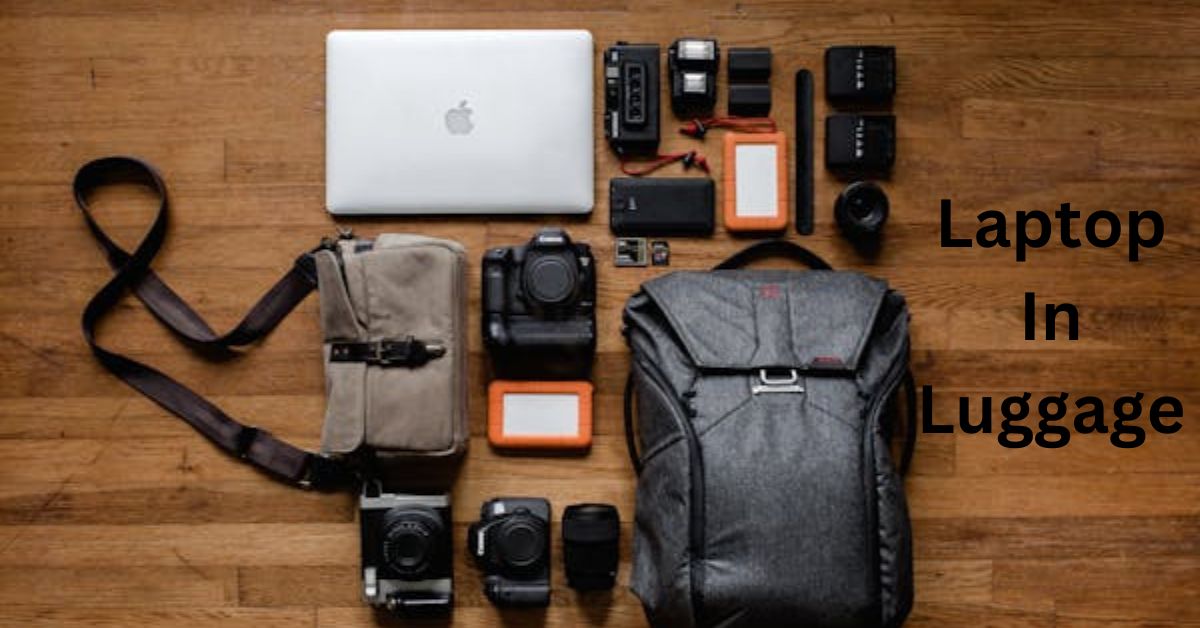Is It Safe to Put Laptop in Checked Luggage?

Traveling with a laptop often raises concerns about its safety, especially when deciding whether to carry it as hand luggage or check it in. Is it safe to put a laptop in checked luggage? The short answer is that it’s generally not recommended due to potential risks. This comprehensive guide explores why and how you can ensure your laptop stays protected during air travel.
Why It’s Not Safe to Put a Laptop in Checked Luggage
1. Risk of Damage
Checked luggage undergoes rough handling during transit, increasing the risk of physical damage to your laptop. From conveyor belts to baggage handling, impacts and pressure can harm the delicate internal components of your device.
2. Temperature Extremes
Cargo holds often experience significant temperature fluctuations. While laptops are built to withstand some variation, extreme cold or heat can affect battery performance and other sensitive parts.
3. Risk of Theft
Checked luggage is not always secure. There’s a higher chance of your laptop being stolen if it’s in your suitcase rather than in your carry-on bag.
4. Flight Restrictions on Batteries
Laptops contain lithium-ion batteries, which are considered hazardous when transported in bulk or subjected to specific conditions. Airlines may restrict or recommend against placing electronics with batteries in checked luggage for safety reasons.
How to Protect Your Laptop if You Must Check It
If checking your laptop is unavoidable, follow these precautions to minimize risks:
1. Use a Protective Laptop Case
Invest in a sturdy, padded laptop sleeve or hard-shell case. This will shield your device from physical impacts and keep it secure inside your luggage.
2. Wrap the Laptop in Clothing
Place your laptop in the center of your suitcase, surrounded by soft clothing. This provides an extra layer of cushioning to absorb shocks during transit.
3. Remove the Battery
If possible, remove the laptop’s battery and pack it in your carry-on bag. This reduces the risk of fire hazards associated with lithium-ion batteries.
4. Encrypt and Back Up Your Data
In case of theft or loss, encrypt your laptop to protect sensitive data. Additionally, ensure all important files are backed up to cloud storage or an external drive.
5. Label Your Luggage
Use luggage tags with your contact details and make your suitcase easily identifiable to prevent mix-ups or loss.
Alternatives to Placing a Laptop in Checked Luggage
1. Carry It in Your Hand Luggage
The best way to ensure your laptop’s safety is to carry it in your cabin bag. This way, you have control over its handling and can access it during the flight.
2. Use Laptop Shipping Services
Consider shipping your laptop to your destination using a reliable courier service. This option provides insurance and specialized packaging for fragile items.
3. Travel With a Lightweight Laptop Bag
A compact, dedicated laptop bag can double as a personal item, allowing you to keep your device close while complying with airline policies.
Airline Policies on Laptops in Checked Luggage
Most airlines discourage placing laptops in checked luggage due to security and safety concerns. While some may permit it under specific conditions, passengers are usually advised to carry their laptops onboard. Always check your airline’s regulations before traveling to avoid complications.
How to Connect Safety and Convenience
The goal of traveling with a laptop is to balance safety and convenience. Keeping your laptop in your carry-on bag ensures it remains accessible while protecting it from potential damage or theft.
Common Mistakes to Avoid
- Packing Without Protection
Placing a laptop directly in your suitcase without a case or padding increases the risk of damage. - Forgetting to Backup Data
Neglecting to back up your data could result in irreparable loss if your laptop is stolen or damaged. - Ignoring Airline Guidelines
Failing to check your airline’s specific rules regarding electronics and batteries can lead to unexpected issues at the airport.
Best Backpacks and Cases for Traveling With Laptops
Investing in a high-quality laptop backpack or case can make all the difference when traveling. Look for features like:
- Padded compartments for extra protection.
- Anti-theft designs with secure zippers.
- Water-resistant materials to guard against spills and weather.
- Lightweight and ergonomic designs for comfort during long journeys.
Tips for Traveling With Electronics
- Keep Essentials in Your Carry-On
Always carry important accessories, such as chargers, adapters, and cables, in your hand luggage to prevent loss. - Avoid Overpacking
Don’t overstuff your luggage. Too much pressure can damage delicate devices like laptops. - Use TSA-Approved Laptop Sleeves
A TSA-approved sleeve allows you to keep your laptop in its case during security checks, reducing the risk of accidental drops.
Advanced Tips for Traveling Safely With Your Laptop
1. Use a Smart Suitcase With Built-In Tech Protection
Smart suitcases are equipped with compartments designed specifically for electronics. These bags often feature built-in locks, shock-resistant padding, and even USB charging ports, making them ideal for protecting your laptop during air travel.
2. Avoid Overheating Risks
Place your laptop in a well-ventilated compartment in your luggage. Avoid placing it near other heat-sensitive items, such as toiletries that may leak due to temperature changes. Additionally, try to ensure that your laptop is powered off completely, as residual heat can damage its components.
3. Purchase Travel Insurance for Electronics
Consider investing in travel insurance that specifically covers electronics. This ensures you can replace or repair your laptop in case of damage, theft, or loss. Review the policy details to confirm coverage for checked luggage items.
4. Use a GPS Tracker for Your Luggage
A small GPS tracker in your luggage can help you locate it if it’s misplaced or delayed. While this won’t directly protect your laptop, it offers peace of mind knowing you can trace your belongings.
The Risks of Placing Laptops in Cargo Holds
1. Compression Damage
The weight of other bags in the cargo hold can create significant pressure, potentially causing the laptop’s screen to crack or its chassis to bend.
2. Risk of Moisture
Humidity and condensation inside the cargo area can expose your laptop to moisture, which may lead to short circuits or corrosion of internal parts.
3. Loss of Connectivity
While not directly physical damage, you may lose immediate access to essential data or presentations stored on your laptop if it’s in checked luggage.
How to Connect Practicality With Peace of Mind
Traveling with a laptop often requires striking a balance between practicality and safety. When you prioritize proper handling and proactive measures, you mitigate risks and ensure your device remains secure. Always think ahead about how your packing choices can impact your laptop’s condition.
Alternative Storage Methods During Travel
1. Use Protective Storage Boxes
Hard-shell storage boxes designed for laptops offer excellent protection against impact and pressure. They’re bulkier but ideal for long trips where safety is a priority.
2. Ship Your Laptop Separately
For extremely valuable or delicate laptops, consider using a professional shipping service. These services often provide insurance and specialized packing materials to ensure the safe arrival of your device.
Preparing Your Laptop for Air Travel
- Backup Files to Cloud Services
Upload your essential documents to cloud platforms like Google Drive, OneDrive, or Dropbox. This way, even if your laptop is lost or damaged, your data remains accessible. - Perform a Full Shutdown
Put your laptop in a completely powered-down state. Avoid leaving it in sleep or hibernate mode to reduce battery strain and accidental overheating. - Secure Your Laptop Physically and Digitally
Physically protect your laptop with a lockable sleeve. Digitally safeguard it with strong passwords, encryption, and multi-factor authentication.
Best Practices for Business Travelers
Business travelers often rely heavily on their laptops for presentations, meetings, and remote work. To maintain productivity while ensuring safety:
- Use lightweight laptop models that are easier to carry.
- Keep presentation backups on both USB drives and cloud storage.
- Opt for a professional laptop bag with multiple compartments for organized packing.
Avoiding Common Mistakes While Traveling With Laptops
Overloading the Laptop’s Compartment
Avoid placing too many accessories in the same compartment as your laptop. Items like chargers or external hard drives can press against the laptop and cause scratches or dents.
Failing to Label Your Laptop Bag
If your laptop bag gets misplaced, labeling it with your contact information increases the chances of its recovery. Avoid generic tags and opt for unique identifiers.
Skipping Regular Inspections
Inspect your laptop periodically during the trip to ensure it hasn’t sustained any damage or overheating in transit.
Essential Accessories for Laptop Travel
- Shockproof Laptop Sleeves
These sleeves provide an added layer of protection, especially for frequent travelers. - Cable Organizers
Keep your chargers, USB cords, and other accessories neatly packed to prevent tangling and accidental pulling. - Portable Power Banks
If you’re traveling to areas with limited charging options, a reliable power bank can keep your laptop running. - Anti-Theft Backpacks
Designed with hidden zippers and slash-proof materials, these backpacks are a safe option for carrying laptops while exploring new cities.
Conclusion
Is it safe to put a laptop in checked luggage? While it’s not entirely safe, following the precautions outlined above can help reduce risks. For optimal safety, always carry your laptop in your hand luggage. If checking it is unavoidable, take steps to protect it from physical damage, theft, and temperature fluctuations. By planning ahead and using the right tools, you can ensure your laptop remains secure and functional throughout your journey.
Also read: how to put stickers on a laptop without ruining it




